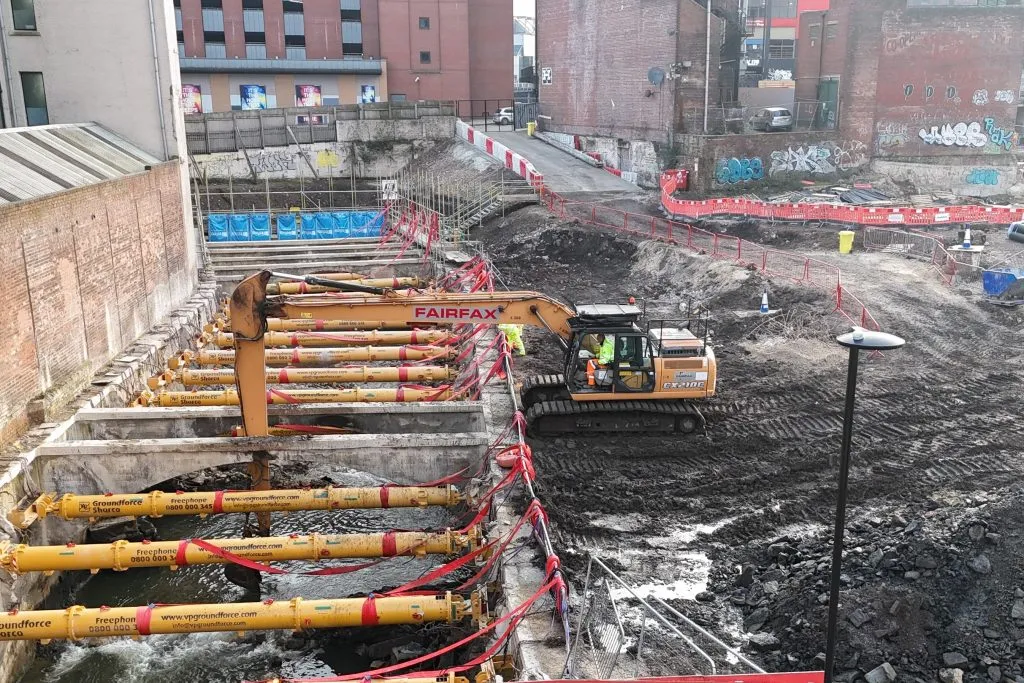Main contractor Aureos has received support from hydraulic prop supplier Groundforce Shorco on Sheffield City Council’s scheme to transform a historic site in the city centre into a new public park, while also exposing a long-hidden section of the River Sheaf.
The Castlegate redevelopment project is being delivered by Aureos, formerly Keltbray, for client Sheffield City Council under the YORcivil Major Works framework.
The project involves the transformation of a former Sheffield market site, which was once home to a medieval castle, into a green public use area, with the remains of the castle on display. As part of the scheme, the project team is also opening up a culverted section of the River Sheaf, which flows along the side of the site.
Aureos began work in January 2024, initially with earthworks to clear the site for archaeological excavation, the delivery of concrete culverts for a new underpass, and demolition of the existing bridge structure above the culvert housing the River Sheaf.
Wessex Archaeology was also involved in uncovering the remains of the castle during the enabling works.
The mains works phase of the project, which began in August 2024, has involved the opening up of the culverted section of the river. Aureos has been supported in the culvert works by Groundforce Shorco.
The concrete culvert, constructed in the early 20th century, is approximately 90m long and lined with mass concrete retaining walls with a continuous in-situ cast concrete roof slab. It is 4m deep, although there is approximately 1.5m of silt lining the riverbed.
The 12m wide, 250mm thick roof slab capped the river and provided lateral support to the culvert walls. Additional support was offered by concrete arches cast at 3m centres along the length of the structure.
The contractor dismantled the roof in 3m segments, which were cut out and lifted clear with a mobile crane. As the roof was broken out, the exposed wall sections were braced using modular hydraulic props supplied by Groundforce Shorco.
Aureos sub-agent Conor Anstey said: “As soon as we’d taken out one section, we dropped a prop in to brace the walls.
“The first couple were a bit tricky, but we quickly got the hang of it, and it was pretty seamless after that.”
In total, 18 of Groundforce Shorco’s MP150 hydraulic props have been used to brace the sides of the culvert, using modified versions of the company’s Mega Brace as a spreader beam against the walls.
Groundforce principal engineer Robert Powell explained: “The Mega Brace is modular and comes in various lengths. The Castlegate scheme used the 1.5m long extensions, which fit nicely between the existing concrete ribs of the culvert structure.
“The beam extensions have fins to the front face, usually used to connect the extensions together to form a longer beam, but the distance between the fins was not sufficient to accept the end bearing plate of the proposed hydraulic struts.
“We added some welded blocks to the face of the beam, just deep enough for the strut end bearing plate to sit in front of the fins and allow connection to the beam.”
Groundforce Shorco has rotated the barrels of the MP150 props to allow access to the hydraulic rams from above, rather than from the side.
“We supplied a set of long hydraulic hoses per strut, allowing them to be left connected after installation,” Powell noted.
“The hoses are accessible for connecting to the hydraulic pump from the safety of solid ground at the side of the culvert. This removes the need to work from height while providing a method of access over the culvert.”
As existing buildings abut the outside wall of the culvert along its entire length, any wall movement poses a risk to these structures. To manage this, real-time remote load monitoring has been installed, providing readings of axial prop loads via an online portal.
“This gives peace of mind that the props are operating within their design limits and the actual loads are in line with anticipated loads from the geotechnical analysis,” said Powell.
All 18 of the Groundforce props have been installed and the roof has been completely dismantled, exposing the river for the first time in decades. However, before the props are removed, permanent support for the culvert walls need to be provided.
The project team plans to remove the old concrete arches and replace some of these with permanent props. Before these go in, the up to 1.5m of accumulated silt must be removed from the riverbed.
Once the permanent supports are installed, the river itself will be “naturalised” with the addition of weirs and fish passes to encourage wildlife to recolonise the river and bring the natural world back into the city centre.
The full Castlegate redevelopment scheme is expected to be completed in 2026.
